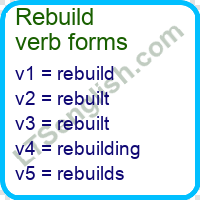Rebuild Past And Past Participle Form V1 V2 V3 V4 V5 Form of Rebuild
Have you ever found yourself puzzled by the different forms of a verb? You’re not alone.
Understanding verb forms is essential for mastering the English language, and one verb that often catches people off guard is “rebuild. ” Whether you’re learning English for the first time or brushing up on your skills, knowing the V1, V2, V3, V4, and V5 forms of “rebuild” can make your life easier.
Imagine having the confidence to use this verb correctly in any context, impressing your peers and enhancing your communication skills. By delving into the past and past participle forms, you can unlock a deeper understanding of how this verb transforms in various tenses. So, why not take a moment to explore these forms and see how they can improve your language proficiency? Your future conversations and writing projects will thank you for it.
Rebuild: Verb Forms And Usage
The verb rebuildhas different forms. These forms show the tense. Understanding these forms helps in using the word correctly. The presentform is rebuild. The pastform is rebuilt. The past participleis also rebuilt. The present participleform is rebuilding. The third person singularform is rebuilds.
“I rebuild old toys.” “She rebuilt the house last year.” “We are rebuilding the bridge.” “He rebuilds cars for fun.” “They have rebuilt the old school.”

Credit: ltsenglish.com
Conjugation Patterns For Rebuild
The verb “rebuild”changes as we use it in time. In the present, we say “rebuild”. It is the base form, also called V1. When talking about something in the past, use the word “rebuilt”. This is the past simple form, or V2.
For actions that happened before now but are still important, use “rebuilt”. This is the past participle form, V3. The present participle, V4, is “rebuilding”. Use it to show ongoing actions. The fifth form, V5, is “rebuilds”. It is used for actions that happen regularly.
| Form | Verb |
|---|---|
| V1 | rebuild |
| V2 | rebuilt |
| V3 | rebuilt |
| V4 | rebuilding |
| V5 | rebuilds |
Application In Sentences
The verb rebuild changes in different forms. It helps describe actions in time. The present form is “rebuild.” For example: “They rebuild the old house.” The past form is “rebuilt.” For example: “They rebuilt the old house last year.” The past participle is also “rebuilt.” It’s used in perfect tenses: “They have rebuilt the old house.” The present participle is “rebuilding.” Example: “They are rebuilding the old house now.” The third person singular is “rebuilds.” Example: “He rebuilds the old car.” These forms show tense and action clearly. They help make sentences accurate. Understanding these forms is useful in speaking and writing. Practice helps use them well. It’s easy with time.

Credit: www.pinterest.com

Credit: englishgrammarhere.com
Conclusion
Understanding the forms of “rebuild” helps with English learning. Remember, it’s “rebuild” in present tense. In past and past participle, use “rebuilt. ” This knowledge aids in better writing and speaking. Practice these forms in sentences daily. With time, you’ll become more confident.
Improving language skills is a journey. Each step is progress. Your grasp of these forms will strengthen over time. Keep learning and practicing. Soon, using “rebuild” will feel natural. Embrace each small improvement. You’re on the right path. Keep going!





